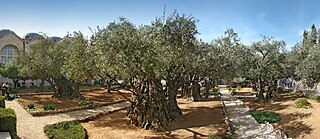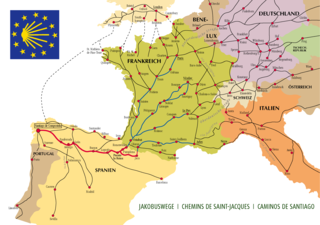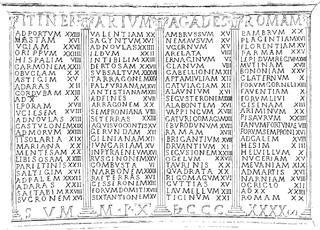This article needs additional citations for verification .(February 2019) |
The Pilgrim's Road or Pilgrims' Road [1] was a route through Asia Minor to the Holy Land. [2]
This article needs additional citations for verification .(February 2019) |
The Pilgrim's Road or Pilgrims' Road [1] was a route through Asia Minor to the Holy Land. [2]
The name Pilgrim's Road has been traditionally given to the network of roads that connected Constantinople with the eastern provinces of the Byzantine Empire such as Syria and Arabia. [3] The route started in Chalcedon, opposite to Constantinople and went to Antioch via Nicomedia, Nicaea, Ancyra, the Cilician Gates and then Tarsus. [4] The surface was paved with small pebbles covered with gravel shortly after the Roman conquest. [2] It was widened from 21.5 feet to 28 feet in the Christian era to accommodate commercial travel. [2]

While the route ensured primarily a rapid connection especially for military forces, pilgrims such as the anonymous pilgrim of Bordeaux who wrote the Itinerarium Burdigalense came to take this route in 333-34 and thus gave it the name Pilgrim's road. Apart from the Itinerarium Burdigalense, two other sources, the Itinerarium Antonini and the Tabula Peutingeriana, describe the route with only one minor divergence between the sources. [4] Pilgrims would also often take detours to visit shrines of saints, such as Egeria who visited the shrine of St. Thecla close to Tarsus in the 380d. [5]
The possibly first prominent pilgrim that took the Pilgrim's road was the mother of Constantine the Great, Helena, whose route was retraced by the author of the Itinerarium Burdigalense and who took around two months to get from Constantinople to Jerusalem in 326. [5] In the century after the Bordeaux pilgrim, possibly on instigation of bishop Basil of Caesarea, many hostels were founded along the road, often by wealthy Roman women. These hostels, also known as xenodochia , resembled earlier Greek or Roman inns but were catering specifically to pilgrims, were operated by monks and were typically funded from Church funds or by donations so that also poor pilgrims could use the facilities. [5]
During the middle Byzantine period the route via Ancyra fell out of favour as the Byzantines preferred the route to the Cilician Gates via Dorylaeum, Amorium and Iconium. There were also several other important roads that branched of the Pilgrim's road to the Amasia and Neocaesarea or to Melitene. [3]

The Church of the Holy Sepulchre, also known as the Church of the Resurrection, is a fourth-century church in the Christian Quarter of the Old City of Jerusalem. The church is also the seat of the Greek Orthodox Patriarchate of Jerusalem. It is considered the holiest site in Christianity in the world and has been the most important pilgrimage site for Christians since the fourth century.

Gethsemane is a garden at the foot of the Mount of Olives in East Jerusalem where, according to the four Gospels of the New Testament, Jesus Christ underwent the Agony in the Garden and was arrested before his crucifixion. It is a place of great resonance in Christianity. There are several small olive groves in church property, all adjacent to each other and identified with biblical Gethsemane.

The Crusade of 1101 was a minor crusade of three separate movements, organized in 1100 and 1101 in the successful aftermath of the First Crusade. It is also called the Crusade of the Faint-Hearted due to the number of participants who joined this crusade after having turned back from the First Crusade.

The Camino de Santiago, or in English the Way of St. James, is a network of pilgrims' ways or pilgrimages leading to the shrine of the apostle James in the cathedral of Santiago de Compostela in Galicia in northwestern Spain, where tradition holds that the remains of the apostle are buried.

Tarsus is a municipality and district of Mersin Province, Turkey. Its area is 2,029 km2, and its population is 350,732 (2022). It is a historic city, 20 km inland from the Mediterranean Sea. It is part of the Adana-Mersin metropolitan area, the fourth-largest metropolitan area in Turkey. Tarsus forms an administrative district in the eastern part of Mersin Province and lies at the heart of the Çukurova region.
Egeria, Etheria, or Aetheria was a Hispano-Roman Christian woman, widely regarded to be the author of a detailed account of a pilgrimage to the Holy Land about 381/2–384. The long letter, dubbed Peregrinatio or Itinerarium Egeriae, is addressed to a circle of women at home. Historical details it contains set the journey in the early 380s, making it the earliest of its kind. It survives in fragmentary form in a later copy—lacking a title, date and attribution.

An itinerarium was an ancient Roman travel guide in the form of a listing of cities, villages (vici) and other stops on the way, including the distances between each stop and the next. Surviving examples include the Antonine Itinerary and the Bordeaux Itinerary. The term later evolved and took wider meanings.

The Battle of Anzen or Dazimon was fought on 22 July 838 at Anzen or Dazimon between the Byzantine Empire and the forces of the Abbasid Caliphate. The Abbasids had launched a massive expedition with two separate armies in retaliation for the Byzantine emperor Theophilos's successes the previous year, and aimed to sack Amorion, one of Byzantium's largest cities. Theophilos with his army confronted the smaller Muslim army, under the Iranian vassal prince Afshin, at Dazimon.

Itinerarium Burdigalense, also known as Itinerarium Hierosolymitanum, is the oldest known Christian itinerarium. It was written by the "Pilgrim of Bordeaux", an anonymous pilgrim from the city of Burdigala in the Roman province of Gallia Aquitania.

In the Roman Empire, a mansio was an official stopping place on a Roman road, or via, maintained by the central government for the use of officials and those on official business whilst travelling.

Church of Saint Peter in Gallicantu is a Roman Catholic church located on the eastern slope of Mount Zion, just outside the walled Old City of Jerusalem, Israel. It is dedicated to the episode from the New Testament known as the Denial of Peter.
Euchaita (Εὐχάϊτα) was a Byzantine city and diocese in Helenopontus, the Armeniac Theme, and an important stop on the Ancyra-Amasea Roman road.

The Palestine Pilgrims' Text Society (PPTS) was a text publication society based in London, which specialised in publishing editions and translations of medieval texts relevant to the history of pilgrimage to the Holy Land. Particular attention was given to accounts by pilgrims and other travellers containing geographical or topographical information, as well as those which discussed the manners and customs of the Holy Land. The original narratives were written in a variety of languages, including Greek, Latin, Arabic, Hebrew, Old French, Russian, and German.

Christianity has a strong tradition of pilgrimages, both to sites relevant to the New Testament narrative and to sites associated with later saints or miracles.
Juliopolis or Ioulioupolis, occasionally also Heliopolis (Ἡλιούπολις), was an ancient and medieval city and episcopal see in Anatolia. In later Byzantine times, it also bore the name Basilaion (Βασιλαίον). Various authors assign it to the regions of Galatia, Bithynia, and Paphlagonia. Now, it is in the province of Ankara, Nallıhan.
The Great German Pilgrimage of 1064–1065 was a large pilgrimage to Jerusalem which took place a generation before the First Crusade.

The Tomb of Lazarus is a traditional spot of pilgrimage located in the East Jerusalem town of al-Eizariya, in Israel, the biblical village of Bethany, on the southeast slope of the Mount of Olives, some 2.4 km east of Jerusalem. The tomb is the purported site of a miracle recorded in the Gospel of John in which Jesus raised Lazarus from the dead.
The anonymous pilgrim of Piacenza, sometimes simply called the Piacenza Pilgrim, was a sixth-century Christian pilgrim from Piacenza in northern Italy who travelled to the Holy Land at the height of Byzantine rule in the 570s and wrote a narrative - an itinerarium - of his pilgrimage.

The Church of the Pater Noster is a Roman Catholic church located on the Mount of Olives in Jerusalem. It is part of a Carmelite monastery, also known as the Sanctuary of the Eleona. The Church of the Pater Noster stands right next to the ruins of the 4th-century Byzantine Church of Eleona. The ruins of the Eleona were rediscovered in the 20th century and its walls were partially rebuilt. Today, France claims ownership of the land on which both churches and the entire monastery are standing, under the Ottoman capitulations and further it claims the land as a French Domaine national français which has been formalised by the Fischer-Chauvel Agreement of 1948, though the agreement has not been ratified by Israel’s Knesset.

The Via Sebaste was a Roman military road in southern Anatolia. Its starting point was Pisidian Antioch on the central plateau, and it ran over the Taurus Mountains, through the Climax Pass down to Perga on the coast. The Roman colonia of Comama and Apollonia lay along its route. There was an eastern branch that connected the colonia of Iconium and Lystra.